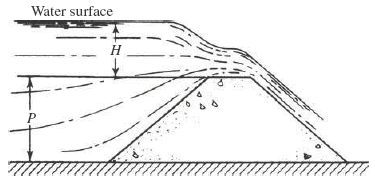Related Resources: calculators
Water Flow Over Rectangular Weir Formula and Calculator
Civil Engineering and Design
Fluid Flow Hydraulic and Pneumatic Engineering and Design Menu
Water Flow Over Rectangular Weirs Formula and Calculator
A weir is a barrier in an open channel over which water flows. The edge or surface over which the water flows is called the crest. The overflowing sheet of water is the nappe.

Figure 1.0 Weir not sharp crested.
If the nappe discharges into the air, the weir has free discharge. If the discharge is partly under water, the weir is submerged or drowned.
The Francis formula for the discharge of a sharp-crested rectangular weir having a length b greater than 3h is
Formulas 1.0
Q = 3.33 ( ( b - n · h ) / 10 ) [ ( h + ho )3/2 - ho3/2 ]
Where:
Q = discharge over weir, ft3/s (m3/s)
b = length of weir, ft (m)
h = vertical distance from level of crest of weir to water surface at poin unaffected by weir drawdown (head on weir), ft (m)
n = number of end contractions (0, 1, or 2)
ho = head of velocity of approach [equal to vo2/2gc, where vo = velocity of approach, (ft/s) (m/s)], ft (m)
gc = 32.2 (lb mass) (ft)/(lb force) (s2)(m/s2)
If the sides of the weir are coincident with the sides of the approach channel, the weir is considered to be suppressed, and n = 0. If both sides of the weir are far enough removed from the sides of the approach channel to permit free lateral approach of water, the weir is considered to be contracted, and n = 2. If one side is suppressed and one is contracted, n = 1.
Related:
- Fluid Flow Regimes Review
- Orifice Plate Flow Calculations and Design
- Pressure Drop Along Pipe Length - Fluid Flow Hydraulic and Pneumatic
- Function for open channel flow rate with input variable for inflow
References:
- Civil Engineering Formulas 2009, Tyler G. Hicks, P.E.,